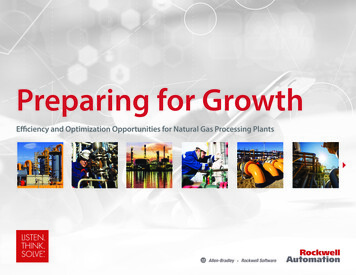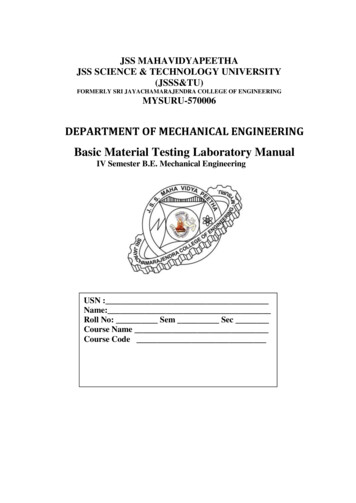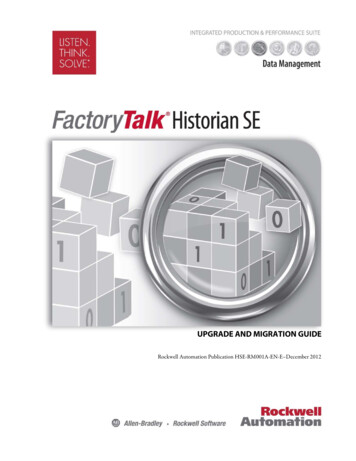
Transcription
Preparing for GrowthEfficiency and Optimization Opportunities for Natural Gas Processing Plants
Gas Processing Industry Seeks EfficienciesEstimates show that by 2040, the global energy mix will evolve dramatically, with the market for natural gas growing more than any other energy type andreaching a quarter of all demand.1 With margins expected to remain tight, securing large investments for plant upgrades and expansions will be a challenge. Industryleaders are instead seeking new efficiencies to streamline production and increase throughput using existing equipment. Many are finding that integration of informationtechnology (IT) and operations technology (OT) systems allows them to make the most of today’s “smart” automation technologies with a relatively minimal investment.Connecting information across your entire gas processing facility allows for productionvisibility that can inform strategic operations decisions to:ReduceMinimizethe risk ofdowntimeenergyconsumptionIncreaseefficiency andreliability ofprocessesAchievegreater throughputwith existingequipmentIn addition to scaling up to meet future demand, gas processing facilities are facing a host of other issues that can impact profitability:Limited visibility into criticalequipment health andperformance PG 3Skid integration is lacking,making it tough to see the bigpicture PG 4Current production and outputdon’t match what the plant wasdesigned to support PG 5Your most poorly producingequipment sets the pace for yourentire facility. Poor equipmentperformance and total equipmentfailure can cost you a lot of timeand money. It can also result indownstream quality issues withyour final sales product.Modular construction techniquescommon in the past decade havecontributed to siloed control andreporting systems, and impededthe ability to gain plant-widevisibility into production.You know your plant can do more.Close the gaps with advancedprocess control. Amine treatment,fractionation, and sulfur recoveryare three areas of the processwhere you can realize quick winsby implementing MPC technology.Ever-evolving cyberthreats can make itdifficult to keep the plantphysically safeand virtually secure PG 6Keeping up with changingcyber security best practicesis a constant challenge, andcyber-attacks are growingin prevalence and severity.Developing strategic safetyand security measures is key.1Diminishing SkilledWorkforce PG 7Gas processing facilities,especially remotely locatedones, have always struggledto find and keep good talent.Advances in technologyare creating additionalpossibilities to operate witha skeleton crew or operatecompletely remotely.ExxonMobil 2017 Outlook to Energy: A View to 2040 Highlights
FUTURIZEYOUR MAINTENANCE STRATEGYGet the Most Out of Your Existing AssetsTame Your Asset Maintenance ProcessMany new plants are discovering a side-effect of enlisting multiple vendors to provide equipment duringinitial construction: gaps in documentation and implementation of asset management technologyacross assets. You can easily remedy this by implementing a centralized asset management tool that:Automatically scans the network to discover connected devices and workstation computersMaintains an inventory of all versions of hardware, firmware and software you need to run your plantAllows for manual entry of additional data, as well as data from devices that are not availableover the networkKeeps detailed records of users’ actions to streamline auditing and reportingHelps you manage instrumentation calibration schedules and certificatesOffers mobile access to real-time informationKeeps your data secureThe right asset management technology can provide a quick boost in your operations because it allowsyou to effectively track the health of assets you already own – regardless of the original manufacturer.Additionally, effective asset management technology surfaces information about assets that waspreviously only available through employees who possessed equipment expertise. This allowsemployees across your organization – regardless of their level of experience with gas processingequipment – to easily access the information they need to keep your assets running well.A comprehensive, plant-wide equipmentmaintenance strategy can quickly lead toless unplanned downtime and significantfinancial savings. Many gas processingfacilities are shifting away from ‘run it untilit dies’ and calendar-based maintenancestrategies and toward predictive andprescriptive maintenance strategies,even on their cheapest and most easilyreplaceable equipment. Why? Downtime inone area of a plant has a ripple effect thatcan impact production output and finalproduct specs across your operations.Condition monitoring is a system orprogram designed to measure machineand process parameters. Alarms are raisedif potential for a fault is detected, allowingoperators to identify and remedy issuesbefore they occur.Condition monitoring solutions can rangefrom simple sensors and handheld datacollectors to comprehensive systems thatintegrate machine protection with yourstandard control system.
TAKE THE COSTOUT OF CONNECTIVITYGain Plant-wide Visibility into PerformancePackage Build Strategy Impacts IntegrationThe shale boom gave rise to a flurry of construction in the gas processing industry as companies raced totake advantage of high oil prices and new production technologies like hydraulic fracking and horizontaldrilling. For the past five to 10 years, everyone was searching for faster, cheaper ways to get a new plant online.As a result, the traditional stick-build design approach for new plants was in many cases tossed to thewayside in favor of a more modular approach: integrating multiple skids from multiple vendors. Thisnew design strategy is referred to as a modular build, modular skid design, and/or package build. Whilethis new strategy offers flexibility, scalability and quicker time to project completion – it can also lead toserious integration challenges. And with large plant builds often requiring services from as many as30 skid builders, it’s crucial to develop a plan for skid integration.Rockwell Automation works with engineering firms, OEMs, and skid builders to establish functional specificationsthat drive down costs by improving project schedule and ease of integration with Rockwell Automationcontrol systems. The PlantPAx modern distributed control system (DCS) offers a scalable and flexibleplatform capable of controlling the entire range of process equipment, including power equipmentlike the Rockwell Automation CENTERLINE MCCs and PowerFlex . Rockwell Automation is uniquelypositioned to manage process, power, and edge device data from both the DCS as well as powermanagement systems like variable frequency drives (VFDs) and motor control centers. Integratingprotocols like EtherNet/IP and 61850 enables operators to gain access to a whole new level of datawhich can help inform optimization efforts and allow for better operational decision-making.FactoryTalk VantagePoint EMI takes muchof the cost out of the data gathering alreadyoccurring by automating data collectionacross multiple systems and platforms.Connectors are included for out-of-the-boxconnections to Rockwell AutomationIntegrated Architecture sources. Connectorsto other systems are available as options.In addition to gathering real-time, live data,FactoryTalk VantagePoint EMI can providetrending context by using information fromFactoryTalk Historian or a third-party historian.CONSIDERATIONSFOR OPTIMAL DATA INTEGRATION: Common Network Protocol: EtherNet/IP Alarming: determining what and when toalarm – and also deciding what not to alarm Standardized HMI securityand visualization Documentation standards
Optimize Your Gas Processing OperationWork Smarter, Not Harder With Model Predictive ControlModel Predictive Control (MPC) technology, a technique for advanced process control, continuously assesses current and predicted operational data,compares that data to the desired results and computes and downloads real-time supervisory setpoint targets.If your current production and output doesn’t match what your plant was originally designed to support, MPC can help you close the gaps. Effectiveuse of MPC can lead to increased process stability and reduced variation for all the distillation towers, increased yield, increased production capacity,reduced energy consumption and reduced emissions.Amine treatment, fractionation, and sulfur recovery are three steps in your production process where you can realize quick wins by implementingMPC technology. To find more information about MPC for gas processing facilities, visit our Gas Processing web page.Amine TreatmentFractionationSulfur RecoveryCustomer Challenges: Unit appears constrained in summerCustomer Challenges: Off-spec fractionation productionCustomer Challenges: Higher SO2 emissions Inefficient energy usage Reduced production rates in summer Unit holds back maximum potentialproduction rate Equipment upsets when feedcompositions change Difficult to respond to acid gascomposition changesMPC Benefits: Increase plant throughput by up to 4% Loss of opportunity to maximize NGLoperation margins Reduce energy in the amine treatmentplant up to 20%MPC Benefits: Increase yield of the most valuable NGLcomponents up to 3% Stabilize Pipeline Gas quality to helpprevent shutdown to sales pipeline Reduce acid gas fluctuation feed to the ClausReactor that could result in emission violations Increase production during summer season Reduce reboil energy consumption up to 10% Increase production capacity up to 5% Hard to respond to ambienttemperature changesMPC Benefits: Reduce SO2 emissions forenvironmental compliance Increase sulfur recovery up to 4%
DEFENSE-IN-DEPTHSECURITYReduce Safety, Compliance and Cyber Security RisksSafetyTargets risk at six levels:PolicyFunctional safety in the gas processing industry can be challenging, especially with constant standardsupdates and technology advances. Whether building a greenfield facility or modernizing your existing facility,understanding safety risk mitigation is critical. Scalable safety instrumented systems (SIS) allow gas processing facilities to apply different levels of riskmitigation as required by their specific needs. The systems are ideal for applications that need distributedsafety, a flexible architecture and mixed safety integrity levels. Pre-engineered SIS solutions also are available to fix capability gaps and address specific businesschallenges in older plants. These systems can help reduce lead times and ease deployments whenreplacing aging or noncompliant safety systems.PhysicalNetworkComplianceIn addition to complying with safety standards and regulations, gas processing facilities must meet stringentenvironmental regulations. With a modern DCS, virtual sensors and visualization software, operators can trackthe flow of gas and monitor emissions, even in areas where measurements are challenging. This informationcan be used to create automation compliance reports and review-by-exception procedures to speedtime-to-market. It can also be used to notify regulatory agencies of potential hazardous releases.SecurityMore connected operations create new opportunities to improve asset utilization, but they also bring greatersecurity risks. Gas processing facilities must deploy a comprehensive security approach to help protect theirintellectual property, people and assets. A defense-in-depth approach assumes that any one security measurecan and likely will be defeated, and therefore uses multiple fronts of protection.Cisco and Rockwell Automation have collaborated to provide a common network and security environmenton a single united network infrastructure for gas processing facilities. Learn more about our strategic alliancewith Cisco on our website.ComputerApplicationDevice
POHOKURASETS THE STANDARDFOR REMOTE OPERATIONSimplify Maintenance and SupportSimplified MaintenanceOperators, especially new hires, are challenged to support the mix of automation technologiesthat comprise today’s gas processing plant. Standardizing or consolidating these technologies bycreating a Connected Enterprise environment can help reduce the number of systems with whichmaintenance technicians and support teams must be familiar.This can help speed up troubleshooting and repairs, and reduce support costs. The ability tocapture and maintain maintenance information also can help companies retain critical “tribalknowledge” before it walks out the door with retiring workers. Today, machine learning and dataanalytics help inform operators and better understand the gas processes they supervise.Remote OperationsGas processing plants can fundamentally rethink goals around worker safety, plant uptime, andequipment maintenance by implementing remote support.Instead of staffing specialists on-site or sending them to a plant following a failure, plant managerscan use remote access to provide support from a centralized location. Or, if they’re struggling tohire or retain internal specialists, they can use third-party remote-monitoring and support servicesto track production performance in real time and alert on-site staff if any issues arise.Pohokura produces over 45% of NewZealand’s natural gas which is reticulatedaround the North Island to industry anddomestic consumption.GOAL:Establish a completely unmannedsite: plant operation to beperformed off-site from a remotecontrol room using a DCSSOLUTION:MCCs were integrated into themain plant control system on anintelligent network so informationfrom the gas station could be fedback to the control room.Power switchgear at the 400VMCCs and the plant 11kV mainswitchboard was made operablefrom the remote control room.The success of the remotely operatedPohokura plant has led to plans to buildanother plant using the same, easilyextendable solution provided byRockwell Automation.
Transforming Gas ProcessingData transformation helps connect gas processing operations to experts across the company and opens the door to an entirely new wayof doing business. It can give gas processing companies immediate relief from the constraints of obsolete equipment. It can also provideconnectivity between skids that allows for a big-picture view of operations. Benefits of implementing a Connected Enterprise:Real-time insights into asset utilization,downtime and product quality to drivecontinuous-improvement effortsMore strategic opportunities to address skillsshortages, such as by using remote monitoringand supportA better understanding of safety,environmental, and security risksNew insights into energy consumptionto drive better energy-usage strategiesSimplified troubleshooting andmaintenance to help reduce downtimeand lower support costsMore opportunities for optimization and improvedefficiencies through data integration and analysis
ResourcesTo learn more about how implementing a Connected Enterprise can help improveyour gas processing operations, visit this web page.Rockwell Automation , Inc. (NYSE: ROK), the world’s largest company dedicated to industrial automation, makes its customers moreproductive and the world more sustainable. Throughout the world, our flagship Allen-Bradley and Rockwell Software product brandsare recognized for innovation and excellence.PlantPAx, Integrated Architecture, FactoryTalk Historian, FactoryTalk VantagePoint EMI are registered trademarks of Rockwell Automation, Inc.EtherNet/IP is a trademark of ODVA Inc.Publication OAG-SP022A-EN-P - March 2018Copyright 2018 Rockwell Automation, Inc. All Rights Reserved.
1 ExxonMobil 2017 Outlook to Energy: A View to 2040 Highlights. . financial savings. Many gas processing . 30 skid builders, it's crucial to develop a plan for skid integration. Rockwell Automation works with engineering firms, OEMs, and skid builders to establish functional specifications .










